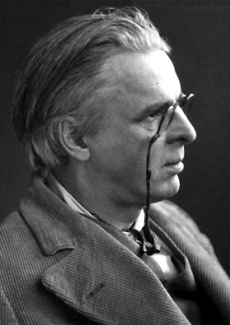
Commonly considered one of the most influential poets of the 20th century, William Butler Yeats was a poet of contradiction and ambiguity; a poet who could write “tread softly because you tread on my dreams” in The Cloths of Haven as easily as state “I carry from my mother’s womb a fanatic heart” in Remorse for Intemperate Speech.
He was born in County Dublin in 1865 to John Butler Yeats and Susan Mary Pollexfen, who were Irish Protestants. Much of the family’s talents lay in the arts. His father was an artist, particularly famous for his portraits. His brother Jack also became an artist and his sisters, Elizabeth and Mary Susan, joined the Arts and Crafts Movement, an international design group which opposed the mechanised architecture of the industrial revolution, rebelling against its presence by going back to romantic and traditional forms of art.
Culture therefore ran through his veins, but looking at his work, we see that he was not just concerned with art, but also with civilisation. In particular, he published a clump of political poems in 1920, including; Easter 1916, Dead Men, The Rose Tree, To a Political Prisoner and Second Coming.
The most famous of these political poems is arguably Second Coming. In it we see a return to Yeats’ apocalyptic ideas from his early days as a political activist, speaking of “anarchy loosed upon the world” and “innocence” being “drowned” – referring to the great flood in Genesis.
But what are these ideas and references alluding to?
Some believe the poem alludes to the Russian Revolution with the references to anarchy and the phrase “the centre cannot hold” being symbolic of Russia’s autocratic regime under Nicholas II. Others believe the allusion is to the Great War, with “The best lack all conviction, while the worst/are full of passionate intensity” being in the same vein as Wilfred Owen and Siegfried Sassoon’s idea that the war was the sacrifice of Europe’s young elite by a callous and cowardly establishment. And some believe it was to do with the conflict in Ireland.
However, in an early manuscript Yeats wrote these words just after the second line: “The Germans are now to Russia come, though every day some innocent has died, the mob to frown upon a murderer”. The fact that these lines were cut from the published edition suggests that Yeats didn’t want the poem to be tied to any specific event of his time. Rather, it is a more ambiguous poem of vision; to do with the grand sweep of history laid out before him.
This reading is further substantiated when we see that the first line mentions a “widening gyre” – a circle. He believes on the basis of his mysticism that the epochs of the world are cyclical, hence the poem being called Second Coming. He therefore envisions a world schism equal to the BC/AD split at the birth of Christ after these “twenty centuries of stony sleep”. And with reference to the Book of Revelation, the last book of the Bible, this poem certainly has a sense of Alpha and Omega, beginning and end between its lines.
It thus becomes an epic poem, in its scope if not in length, and a prime example of how Yeats was a master of words who combined the cultural and political in his poems.
Image: See page for author [Public domain or Public domain], via Wikimedia Commons

0 Comment:
Be the first one to comment on this article.